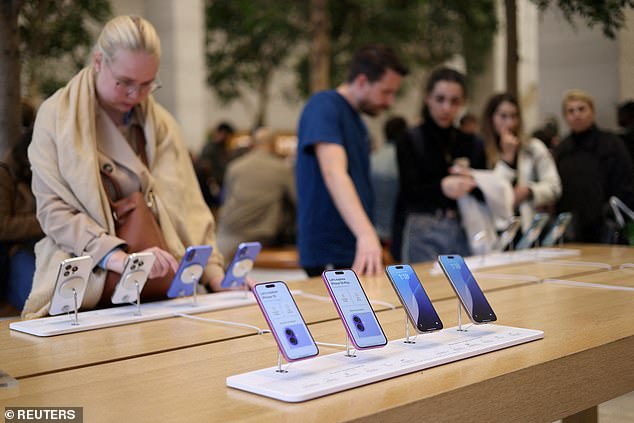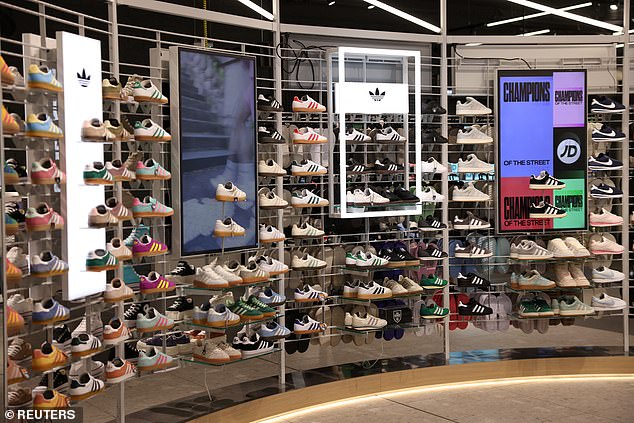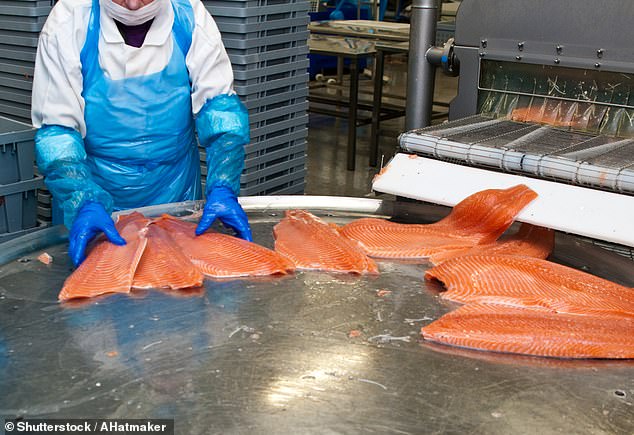Donald Trump unveiled a range of tariffs last Wednesday, with a 10 per cent ‘baseline’ import tax slapped on every country that sends goods to the US.
This means the UK will be hit with the 10 per cent tariff on its exports – although car, steel and aluminium exports will all come under a 25 per cent tariff.
Among the industries that could be worst-hit in Britain are carmakers, technology companies, clothing brands and whisky manufacturers.
Here, MailOnline looks at what products could be most affected by the plans and what it means for the price of goods bought by households in the UK.
CARS
Britain’s carmakers will be among the companies worst hit by Donald Trump’s ‘Liberation Day’ after a 25 per cent import tariff was slapped on foreign vehicles.
Jaguar Land Rover has already confirmed it will pause shipments to the US for two weeks while it weighs up if it can increase prices for American customers.
If manufacturers like JLR, which has 38,000 British workers, lose sales in the US they could cut back production – which likely means lower supply in the UK too.

The Land Rover Defender is one of Jaguar Land Rover’s most popular vehicles and US exports
If UK demand remains unchanged, motorists will probably see prices go up – with makers also potentially trying to claw back losses from the impact of US tariffs.
But UK demand could also fall if the country enters a period of economic uncertainty and people put off buying a car, which could therefore result in a fall in prices.
JLR’s bestsellers include its Land Rover Defender and Range Rover Sport, and the Coventry-based firm sold 430,000 cars last year – a quarter of them in America.
Other major carmakers with UK factories include BMW near Oxford; Rolls-Royce in Goodwood, West Sussex; and Aston Martin in Gaydon, Warwickshire.
These firms will hope their customers accept the impact of the tariffs being passed on, although it remains to be seen how much of an impact this will have on prices.
MOBILE PHONES
Industry analysts believe consumer goods such as iPhones could be among the hardest hit by Donald Trump’s tariffs, with 40 per cent price rises possible.
Most iPhones are still made in China, which now faces a 54 per cent tariff. If those levies persist, Apple must either absorb the extra expense or pass it on to customers.
The cheapest iPhone 16 was launched in the US with a price of $799 (£619), but could cost as much as $1,142 (£885), based on projections by Rosenblatt Securities.

Apple iPhone 16 smartphones are displayed at a store in London
The experts say the cost in the US could rise by 43 per cent if Apple is able to pass that on to consumers.
A more expensive iPhone 16 Pro Max, with a 6.9-inch display and 1 terabyte of storage, which currently retails at $1599 (£1,239), could cost nearly $2300 (£1,782) if a 43 per cent increase were to be passed to consumers.
This could also have an impact on prices in the UK, if Apple decides to increase the price by the same amount in Britain – or it could increase both UK and US prices by a smaller amount.
But Angelo Zino, equity analyst at CFRA Research, said the company will have a tough time passing on more than 5 to 10 per cent of the cost to consumers.
He added: ‘We expect Apple to hold off on any major increases on phones until this fall when its iPhone 17 is set to launch, as it is typically how it handles planned price hikes.’
Any price rises for Apple could also give South Korea’s Samsung an edge, as the country faces lower tariffs than China, where all iPhones sold in the US are made.
CLOTHING & FOOTWEAR
Clothing and footwear retailers that export goods to the US and other countries from international markets could also be significantly affected by the President’s tariffs.
Kate Calvert, an analyst for Investec Economics, highlighted the new 46 per cent tariff on Vietnam, 49 per cent on Cambodia, and 42 per cent on Indonesia.
These charges could result in higher costs for retailers that source materials or manufacture from these countries and sell goods in the US.

Adidas trainers are displayed at the JD Sports store at Westfield Stratford City in London
Some companies could be ‘hit hard’, with the likes of Adidas and Nike and most athleisure brands particularly affected, she said.
UK retailers JD Sports, Dr Martens, Watches Of Switzerland, Asos, and WH Smith were all flagged for having a significant proportion of their sales generated in the US.
Some also import heavily from international markets. Shares in US-based Adidas was tumbling by a tenth last Thursday, while British retailer JD Sports fell nearly 5 per cent. Watches Of Switzerland shares plunged by about 15 per cent in one afternoon.
Ms Calvert said the impact of new tariffs were unlikely to immediately raise prices, but that exposed companies would have to ‘make decisions pretty quickly’.
WHISKY
Spirits and other alcoholic drinks are among the UK’s most significant export sectors, particularly in Scotland due to global demand for scotch whisky.
Industry bosses fear the tariff plans will hit a key market for whisky and gin, with the Scotch Whisky Association trade body saying it was ‘disappointed’.
The US is the most important overseas market for Scotch whisky makers, worth more than £970million a year, but the impact on prices is as yet unknown.

The Scotch Whisky Association trade body said it was ‘disappointed’ by the tariffs decision
There are also concerns of a drop in demand for the growing industry of whisky tourism to Scotland if exchange rates became unfavourable to Americans.
Whisky prices could go up for consumers in the US if the producers cannot absorb the added cost, which may lead to a drop in demand from Americans.
Producers could also choose to raise prices for both Americans and Brits to help offset the tariff impact – without passing on the full extra costs to the Americans.
Anthony Wills, who runs the Kilchoman distillery on the island of Islay, told the BBC that the prospect of tariffs was ‘a huge blow for the industry’.
But while Scotch whisky faces a 10 per cent tariff, there is a shred of good news in that their Irish and Japanese competitors face higher increases for US exports.
SALMON, CHOCOLATE AND CHEESE
American is a major importer of British foods such as salmon, chocolate and cheese – with around 6,000 tonnes of cheddar shipped to the US last year.
But tariffs on such products could result in UK exporters having to pass this onto US shoppers which could result in a drop in demand from Americans.
This may then have a knock-on impact on British shoppers if UK firms feel they need to increase prices to offset lower sales in America.

Salmon Scotland is ‘confident’ Americans will continue to purchase imported Scottish salmon
However, Salmon Scotland, which represents every company involved in salmon farming in Scotland, said it was ‘confident’ US consumers would continue to purchase imported Scottish salmon.
The cost of buying food exported from the European Union into Britain could also be impacted if those manufacturers have to increase prices to cover the 25 per cent tariff they face.
The price of foil, kitchenware and drinks cans sold in the UK could also be affected given Mr Trump’s tariffs on aluminium imports to the US.
HOUSE PRICES
Richard Donnell, executive director at Zoopla, said the housing market is an extension of the UK economy, which sits in the global economy.
He said: ‘The housing market has largely adjusted to higher borrowing costs and slower economic growth. The impact of (Mr) Trump’s tariffs is complex to asses but overall its likely to suppress UK economic growth and keep inflation at levels that limit how much base rates will be cut in the near term.
‘Our outlook for the housing market was based on average mortgage rates remaining around 4.5 per cent over 2025. We still expect sales to grow over 2025 but price growth may slow more than expected as the market adjusts to the new stamp duty rates and increased caution by buyers on what to pay for homes.’
EASTER HOLIDAYS
Sarah Coles, Head of personal finance at Hargreaves Lansdown, said the pound has been gaining ground since a ‘tricky January’ so ‘anyone who hasn’t checked the exchange rate for a few months is in for a pleasant surprise’.
The strength – or weakness – of the pound will depend on the destination.
Ms Coles said that those travelling to Europe may find their ‘holiday spending money stretched a bit thinner. As the dollar fell, money flooded into alternative currencies, and the euro was a key beneficiary’.
She added: ‘As ever with holiday money, the biggest difference you can make is in finding a decent exchange rate.
‘If you use a fee-free debit or credit card, or shop around for a decent exchange rate plenty of time in advance, instead of buying at the airport or paying card fees, you can more than make up for any currency movements.’







